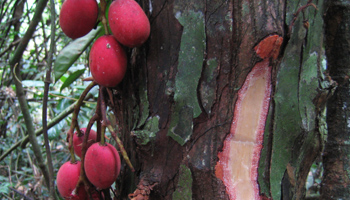21.01.2014
Tropical forests: even more complex in their diversity than at first apparent
The University of Fribourg has collaborated in an international study which proves that the seasonal inversion at the equator is a contributing factor in determining the structure of the Central African rainforests. Since each tree taxon is characterised by its own pattern of genetic diversity, this emphasises once again the urgent need for a detailed analysis of the biodiversity of these forests, endangered as they are by global climate change.

Trichoscypha acuminata, the “Gabon grape” whose sweet and juicy fruits sprout directly from the trunk. (Photo: Myriam Heuertz)
The factors which determine the structure of biodiversity in tropical rainforests have for a long time puzzled researchers. This is because the tropical regions are not affected by the north-south temperature gradient which is largely responsible for the areas of distribution of temperate zone species and for the structure of their genetic diversity. In collaboration with research institutions in Belgium, Spain, Cameroon, and the United Kingdom, a researcher in the Department of Biology at the University of Fribourg as the holder of an Intra-European Fellowship for Career Development (IEF, Marie-Curie Action), Myriam Heuertz, has shown that it is the seasonal inversion at the meteorological equator which is the main factor in explaining the genetic structure of a sample of Central African tree species.
History and genetic structure
In this study, published last January 8 in the on-line scientific journal PLOS ONE, the authors compared the distribution of the genetic diversity of fourteen tropical tree taxa in the Central African region of Lower Guinea, predominantly Cameroon and Gabon. They analysed the genetic sequence of a region of chloroplast DNA which enabled them to examine the history of the forests’ vegetation. Chloroplast DNA is transmitted from generation to generation via seed and thus reflects the history of the areas of distribution of the trees. The genetic structure of these tree taxa could not be explained by the West-East continental gradient of the region, nor by the seasonal inversion. On the other hand, it suggested two possible explanations: either the tree taxa had different evolutionary histories or there was a shared pattern, but it was too weak to be detectable in the dataset. The more detailed analysis of four tree species confirmed the second hypothesis: the meteorological equator coincides with a genetic discontinuity of these species, among which are the iroko which is sought after for its wood and the “Gabon grape” whose sweet and juicy fruits are easily harvested since they sprout directly from the trunk.
The authors have also discovered that the tropical African tree taxa often harbour a genetic diversity which is so great that it allows for the inclusion under the same taxon name of several distinct, but morphologically very similar species. This demonstrates the urgency of the need to study the evolution and the functioning of the biodiversity of these tropical forests, as global climate change could cause the disappearance of tree species not yet scientifically described, resulting in a serious loss of resources to ecosystem services, including the discovery of medicinal substances.
Link to the Study:
http://dx.plos.org/10.1371/journal.pone.0084307
Contact:
Myriam Heuertz, Department of Biology, myriam.heuertz@unifr.ch, 026 300 88 59
